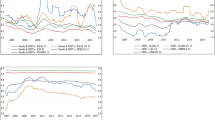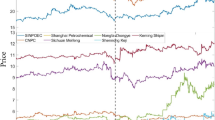Abstract
This study investigates the changing relationship between price and volume traded of short- and long-maturity NYMEX light sweet crude oil futures contracts and major changes in the physical crude oil market during the last decade. Monthly series for the #1-month to 84-month out maturity contracts are generated from daily price and volume data for NYMEX West Texas Intermediate (WTI) futures contracts for the period from January 2000 to the middle of 2009. 3-D graphical analysis of the futures prices, contract volumes, maturity dates, and time is used to demonstrate the changing trading volume pattern and evolution of the shape of futures price term structure across various contract maturities in different market regimes. The study observes the impacts of both May 2004, when excess production capacity reached nearly zero, and September 2006, when electronic trading was implemented on the NYMEX WTI futures markets. This analysis will be used to determine if futures contract information can provide an early indication of market regime shifts and improve short-run crude oil spot price forecast models.








Similar content being viewed by others
Notes
Much research has been devoted to the comparison of the markets before and after the introduction of electronic trading in terms of various market efficiency measures. See for example, Evans (2006) on UK financial futures; Skouratova et al. (2008) on market quality changes measured by changes in volume, bid-ask spread, price clustering, price discovery, and market depth in crude oil futures; Tse and Xiang (2005) analyzed e-mini energy futures; Fung et al. (2005) on the Hang Seng Index futures; and Gilbert and Rijken (2006) on LIFFE FTSE 100.
Trading terminates at the close of business on the third business day prior to the 25th calendar day of the month preceding the delivery month. If the 25th calendar day of the month is a non-business day, trading shall cease on the third business day prior to the business day preceding the 25th calendar day. The contract termination schedule is available at www.nymex.com.
In other words, let F(k, t) be the spread with k month maturity in month t, where k = 1 to 84, and t = January 2000 to June 2009. We have
$$ F\left( {k,\,t} \right) = P\left( {k,t} \right)-P\left( {1,t} \right) $$or \( = 0\;\,if\,P\left( {k,t} \right) \) is not available in the end of the price term structure.
For those contacts which are not traded, F(k, t) is interpolated from the nearest available maturity prices. However, for presentation purposes, contacts with maturities longer than the longest traded contract have the price set to zero.
See also Fig. 8 below for typical normal, transitional and inverted futures price term structure.
Log values are used to visually diminish the huge differences in volume between short maturity contracts and long maturity contracts. For 3-D graphs, there are tradeoffs between most informative rotation angle and easiest reading of the axis directions. The graphs are most informative when shown in rotation.
Note that dark blue indicates 10s of contracts; light blue indicates 100s of contracts; whereas yellow indicates 10,000s of contracts and orange indicates 100,000s of contracts traded during the month.
Let V head(t) be the cumulative volume from contract maturity of 1 month up to the kth month, or
\( {V_{head}}(t) = \sum\limits_{k = 1}^{{K_{head}}} {V(k,\;t)} \); and the percentage share of the head be θ(t) in month t, or \( \theta (t) = \frac{{{V_{head}}(t)}}{{V(t)}} \). (Note that Khead is fixed and θ(t) changes over time.)
Detailed regression results for seasonality and trend are available to interested readers.
Detailed Granger causality test results are available to interested readers.
Recalling from footnote 7, we have \( {\theta_{head}} = \sum\limits_{k = 1}^{K(t)} {\frac{{V(k,\;t)}}{{V(t)}}} \).
(Note that θ head is fixed but K(t) changes over time).
The uses of the terms contango (normal shape) and backwardation (inverted shape) can be confusing. There are people who use them correctly and those use them “incorrectly.” See Harper’s article entitled “Contango vs. Normal Backwardation” at http://www.investopedia.com/articles/07/contango_backwardation.asp.
Several papers are identified in the literature. For example, Ma (1989) directly addresses the issue of use information on futures to forecast spot price, and Chantziara and Skiadopoulos (2008) try to forecast the term structure of petroleum futures. Hassan (1995) tested the relationship between futures prices and expected future spot prices. For studies on price spread and terms structure, see also, Geman (2008) and Bessembinder, et al. (1995).
References
Bessembinder, H., Coughenour, J. F., Seguin, P. J., & Smoller, M. M. (1995). Mean reversion in equilibrium asset prices: evidence from the futures term structure. Journal of Finance, 50(1), 361–375.
Chantziara, T., & Skiadopoulos, G. (2008). Can the dynamics of the term structure of petroleum futures be forecasted? Evidence from major markets preview. Energy Economics, 30(3), 962–985.
Cortazar, G., & Schwartz, E. S. (2003). Implementing a stochastic model for oil futures prices preview. Energy Economics, 25(3), 215–238.
Davidson, P. (2008). Crude oil prices: market fundamentals or speculation? Challenge, 51(4), 110–118.
Evans, T. (2006). Efficiency tests of the UK financial futures markets and the impact of electronic trading systems. Applied Financial Economics, 16(17), 1273–1283.
Fung, J. K. W., Lien, D., Tse, Y., & Tse, Y. K. (2005). Effects of electronic trading on the Hang Seng index futures market. International Review of Economics and Finance, 14(4), 415–425.
Geman, C. K. (2008). WTI crude oil futures in portfolio diversification: the time-to-maturity effect. Journal of Banking and Finance, 32, 2553–2559.
Gilbert, C. L., & Rijken, H. A. (2006). How is futures trading affected by the move to a computerized trading system? Lessons from the LIFFE FTSE 100 contract. Journal of Business Finance and Accounting, 33(7–8), 1267–1297.
Gülen, S. G. (1998). Efficiency in the crude oil futures market. Journal of Energy Finance and Development, 3(1), 13–21.
Hamilton, J. (2009). Understanding crude oil price. Energy Journal, 30(2), 179–206.
Hassan, M. M. (1995). S&P 500 futures market and the normal backwardation hypothesis. Journal of Economics and Finance, 19(3), 85–103.
Kilian, L. (2009). Not all oil price shocks are alike: disentangling demand and supply shocks in the crude oil market. America Economics Review, 99(3), 1053–1069.
Krugman, P. (2008). The oil non-bubble. New York Times, May 12
Ma, C. W. (1989). Forecasting efficiency of energy futures prices. Journal of Futures Markets, 9(5), 393–419.
Manoliu, M., & Tompaidis, S. (2002). Energy futures prices: term structure models with Kalman filter estimation. Applied Mathematical Finance, 9(1), 21–43.
Ripple, R. D., & Moosa, I. A. (2007). Hedging effectiveness and futures contract maturity: the case of NYMEX crude oil futures. Applied Financial Economics, 17(7–9), 683–689.
Schwartz, E., & Smith, J. (2000). Short-term variations and long-term dynamics in commodity prices. Management Science, 46(7), 893–911.
Skouratova, E., Tse, Y., Martinez, V. (2008). Market competition in crude oil futures. Working Paper, Department of Finance, University of Texas at San Antonio.
Tse, Y., & Xiang, J. (2005). Market quality and price discovery: introduction of the e-mini energy futures. Global Finance Journal, 16(2), 164–179.
Ye, M., Zyren, J., & Shore, J. (2005). A forecasting model for monthly crude oil spot price. International Journal of Forecasting, 21(3), 491–501.
Ye, M., Zyren, J., & Shore, J. (2008). The recent disconnect in the crude oil price and inventory relationship. Journal of Energy Development, 32(1), 93–103.
Ye, M., Zyren, J., Blumberg, C. J., & Shore, J. (2009). A forecast model for short-run crude oil price with a Ratchet effect. Atlantic Economic Journal, 37(1), 37–50.
Author information
Authors and Affiliations
Corresponding author
Additional information
The views expressed are those of the authors, and do not necessarily reflect those of the Energy Information Administration. Authors also would like to acknowledge their sincere appreciation to Judi West for her patience and capability in processing the original huge and messy dataset.
Rights and permissions
About this article
Cite this article
Ye, M., Zyren, J., Shore, J. et al. Crude Oil Futures as an Indicator of Market Changes: A Graphical Analysis. Int Adv Econ Res 16, 257–268 (2010). https://doi.org/10.1007/s11294-010-9266-z
Published:
Issue Date:
DOI: https://doi.org/10.1007/s11294-010-9266-z




